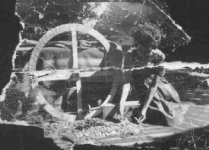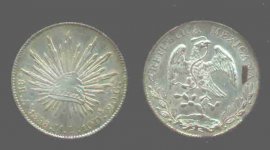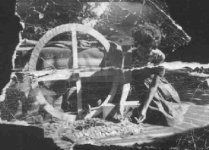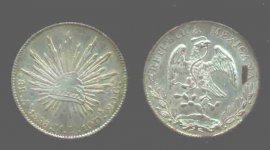You are using an out of date browser. It may not display this or other websites correctly.
You should upgrade or use an alternative browser.
You should upgrade or use an alternative browser.
metal detecting before 1965
- Thread starter bigticket
- Start date
slow sweeper
Sr. Member
I think they were called mine sweepers back then. 

TXKajun
Full Member
bigticket, it just so happens my first detector was a White's TreasureMaster.....vintage 1965. Course, I got it late last year at an auction for $5!
I now have an Ace 250 and a Minelab Eureka Gold. Compared to the 2 new machines, the old White's is absolutely primitive. BUT (and that's a big but, in case you hadn't noticed! LOL) I did manage to find some coins and a large plumb bob with the White's. And most of what I found was on locations that had already been hunted.
The White's has an on/off switch, a battery check switch with a position for checking ALL 3 BATTERIES....yep, a 67.5 volt big honker, a special 9 volt and a 1.5 volt battery needed for operation... a dial for sensitivity/discrimination/balance and a switch to set to metal or mineral. It also came with a 12" round coil. BTW, did I mention that sucker's rather heavy? Probably pushing 5 lbs and has a straight shaft. It'll go about 5" deep on coins and pinpointing is not too difficult...the sweet spot seems to be at about the 5 o'clock position on the coil. Instead of a nice tone, it had more a motorboat kinda sound that was adjustable with a large dial. Ground balancing/sensitivity setting was done with the dial at 50, detector about 2' above ground, adjust dial downward until slow motor-boat sound heard, then lower detector to about 1" above ground. Motor-boat sound stops and you're ready to detect. When you detect something, motor-boat sound comes back. Speed and loudness of motorboat sound showed depth/size of target. Then ya dig. Anything and everything. It didn't stabilize for about 1/2 hour. Had to keep tweaking the dial until it did. But it worked! And it's only cost me what, a bit over $1200 since then!
One thing to remember, back in 1965, not a lot of folks had detectors and there was probably as much stuff out there as there is now, but given the number of detectors, I bet there were lots more finds made, especially silver coins. Also, the folks I remember having them back then (I was just starting high school in '65) were pretty much geeks.....at least that's what we considered them then. No headphones, but walking around waving this thing on a stick?? Who would do THAT LOLOL
LOLOL
It'll be interesting to hear from some of the folks that actually did get their start detecting back then.
HH, ya'll!
Kajun
I now have an Ace 250 and a Minelab Eureka Gold. Compared to the 2 new machines, the old White's is absolutely primitive. BUT (and that's a big but, in case you hadn't noticed! LOL) I did manage to find some coins and a large plumb bob with the White's. And most of what I found was on locations that had already been hunted.
The White's has an on/off switch, a battery check switch with a position for checking ALL 3 BATTERIES....yep, a 67.5 volt big honker, a special 9 volt and a 1.5 volt battery needed for operation... a dial for sensitivity/discrimination/balance and a switch to set to metal or mineral. It also came with a 12" round coil. BTW, did I mention that sucker's rather heavy? Probably pushing 5 lbs and has a straight shaft. It'll go about 5" deep on coins and pinpointing is not too difficult...the sweet spot seems to be at about the 5 o'clock position on the coil. Instead of a nice tone, it had more a motorboat kinda sound that was adjustable with a large dial. Ground balancing/sensitivity setting was done with the dial at 50, detector about 2' above ground, adjust dial downward until slow motor-boat sound heard, then lower detector to about 1" above ground. Motor-boat sound stops and you're ready to detect. When you detect something, motor-boat sound comes back. Speed and loudness of motorboat sound showed depth/size of target. Then ya dig. Anything and everything. It didn't stabilize for about 1/2 hour. Had to keep tweaking the dial until it did. But it worked! And it's only cost me what, a bit over $1200 since then!

One thing to remember, back in 1965, not a lot of folks had detectors and there was probably as much stuff out there as there is now, but given the number of detectors, I bet there were lots more finds made, especially silver coins. Also, the folks I remember having them back then (I was just starting high school in '65) were pretty much geeks.....at least that's what we considered them then. No headphones, but walking around waving this thing on a stick?? Who would do THAT
 LOLOL
LOLOLIt'll be interesting to hear from some of the folks that actually did get their start detecting back then.
HH, ya'll!
Kajun
It was certainly was a different time. I was only a pioneer(pre 1965) in my area which was the Mid-West. Metal detecting was at that time very popular in the South with the CW relic crowd. In fact the die hard relic hunters felt that the centennial 1961-64 killed it for them with the increased number of relic hunters. I remember at that time asking several homeowners around the Bull Run Battlefield if I could detect around their property. All but one refused me permission. They said the earlier folks had found swords, pistols, complete rifles,and buckles around the various properties. So even in the 60's I was late. However, I found the old churches completely untouched around CW battlefield sites and did manage to acquire some Spanish reales and CW relics from these sites during my vacation jaunts.
I guess we didn't know how good we had it. I only detected virgin areas such as parks, schools, and churches. I won't have gotten off my motorcycle to detect a coin area if I knew it was detected before by someone else. However, it was many years before I had any competition. It was a rush to know that you were the first to detect this choice spot.
All high traffic areas such as schools and parks had incredible amounts of silver as clad had not been introduced yet. Finding 30 to 50 silver coins per outing at high traffic areas was pretty common. My one day record was 132 silvers which was at an arcade site. Finding several silver halves at a virgin school yard or park was a common everyday experience. When I started finding clad coins I showed these to my friends not the silver as clad was corroded and rare. Using topo maps(cost 50 cents at the time) I would locate old churches and spend the day detecting and would always return with a pocketfull of old coins.
Using BFOs at that time required incredible patience as you had to dig everything. Some iron you could tell was definitely iron and I felt I could distinguish a coin but still you dug them all. Pull tabs were not a problem as they were only recently introduced. The real pain was tin foil which sounded like a deep coin. You were also depth limited as 6" for a small coin was about it. Bye and Bye I felt that more seated coinage has been found today than back then just because of the depth factor.
The impact of finding $7 in coinage at a park in 1965 is quite different than today. In 1965 you could fill your car up with gas and have a nice lunch for $7.
George
I guess we didn't know how good we had it. I only detected virgin areas such as parks, schools, and churches. I won't have gotten off my motorcycle to detect a coin area if I knew it was detected before by someone else. However, it was many years before I had any competition. It was a rush to know that you were the first to detect this choice spot.
All high traffic areas such as schools and parks had incredible amounts of silver as clad had not been introduced yet. Finding 30 to 50 silver coins per outing at high traffic areas was pretty common. My one day record was 132 silvers which was at an arcade site. Finding several silver halves at a virgin school yard or park was a common everyday experience. When I started finding clad coins I showed these to my friends not the silver as clad was corroded and rare. Using topo maps(cost 50 cents at the time) I would locate old churches and spend the day detecting and would always return with a pocketfull of old coins.
Using BFOs at that time required incredible patience as you had to dig everything. Some iron you could tell was definitely iron and I felt I could distinguish a coin but still you dug them all. Pull tabs were not a problem as they were only recently introduced. The real pain was tin foil which sounded like a deep coin. You were also depth limited as 6" for a small coin was about it. Bye and Bye I felt that more seated coinage has been found today than back then just because of the depth factor.
The impact of finding $7 in coinage at a park in 1965 is quite different than today. In 1965 you could fill your car up with gas and have a nice lunch for $7.
George
bigticket
Full Member
- Nov 9, 2005
- 121
- 5
- Thread starter
- #6
That is really funny about the centennial. Also what you wrote about clad.
I have seen something about 19th century coins, which was similar to what you wrote (about seated coins). Even though today's detectors can sense deeper targets, I think that back then, perhaps metal detectorists found so many newer coins (and money was worth more back then) that maybe they did not worry that much about finding older coins. What do you think? Did you consider it a big deal back then when you found a really old coin?
Also, as for the greater value of money back then, no one ever seems to mention what you pointed out: even if you only found a few dollars, that amount had a lot of purchasing power back in those days. Treasure hunters had it much better back then, and not just because there were so many unhunted places.
I have seen something about 19th century coins, which was similar to what you wrote (about seated coins). Even though today's detectors can sense deeper targets, I think that back then, perhaps metal detectorists found so many newer coins (and money was worth more back then) that maybe they did not worry that much about finding older coins. What do you think? Did you consider it a big deal back then when you found a really old coin?
Also, as for the greater value of money back then, no one ever seems to mention what you pointed out: even if you only found a few dollars, that amount had a lot of purchasing power back in those days. Treasure hunters had it much better back then, and not just because there were so many unhunted places.
Finding common old coinage such as Indian Heads anytime you detected an old church was simply par for the course. I amassed a quart jar about 3/4 full of IHs. However, seated coinage for me was rare. The times I found them were in old tavern ruins or home sites on very hard gravel or cinders. They just didn't sink in these hard surfaces. Typically I would eyeball them first just before the coil passed over them. I would see these green globs on some cinders and just become the coil hit it I would think "Large Cent" and it would be so. Now the rest of the areas in the grass would produce nothing so I assumed the deep coins were out of the range of my BFO. So the ground conditions in Ohio I felt favored deep old coins and the state wasn't settled earlier like Pa. NY or Va. which would produce much older coins.
Now the area of great coin shooting in the early days(still today) was always in the east. I would go out detecting in the summer for 2 weeks at a time detecting in Pennsylvania and Virginia. The further east you went the more incredible your coin finds would become. I would just live off the land so to speak for a couple of weeks. My goal was to detect old sites and I would tour the countryside detecting everyday. Anytime I needed money I would go to a small town and detect around the parking meters(or schools or parks if virgin) for gas and food money and then off for more old site detecting. I either camped out or slept in my car(Yes I was a foolish teenager). When I returned after 2 weeks I had about the same money as I started with but with an incredible mass of old coins and relics and memories to last a long time.
Actually I thought at the time that this hobby would be finished by the 70's- after all who would want to detect a site which had been detected dozens of times before(today hundreds of times). The real thrill was being a pioneer and putting your coin over virgin ground to bring to light a coin or relic which had been there for a 100 years. I was wrong of course and really do admire the youngsters today who have such good patience and perseverance.
George
Now the area of great coin shooting in the early days(still today) was always in the east. I would go out detecting in the summer for 2 weeks at a time detecting in Pennsylvania and Virginia. The further east you went the more incredible your coin finds would become. I would just live off the land so to speak for a couple of weeks. My goal was to detect old sites and I would tour the countryside detecting everyday. Anytime I needed money I would go to a small town and detect around the parking meters(or schools or parks if virgin) for gas and food money and then off for more old site detecting. I either camped out or slept in my car(Yes I was a foolish teenager). When I returned after 2 weeks I had about the same money as I started with but with an incredible mass of old coins and relics and memories to last a long time.
Actually I thought at the time that this hobby would be finished by the 70's- after all who would want to detect a site which had been detected dozens of times before(today hundreds of times). The real thrill was being a pioneer and putting your coin over virgin ground to bring to light a coin or relic which had been there for a 100 years. I was wrong of course and really do admire the youngsters today who have such good patience and perseverance.
George
Charlie P. (NY)
Gold Member
- Feb 3, 2006
- 13,004
- 17,107
- Detector(s) used
- Minelab Musketeer Advantage Pro w/8" & 10" DD coils/Fisher F75se(Upgraded to LTD2) w/11" DD, 6.5" concentric & 9.5" NEL Sharpshooter DD coils/Sunray FX-1 Probe & F-Point/Black Widows/Rattler headphone
- Primary Interest:
- Metal Detecting
I received a Radio Shack metal detector kit for Christmas that was probably from around 1969. The "coil" was a bare printed circuit board with the upper and lower "windings" etched in the board. It would detect a '64 Rambler from several inches in air tests.  I actually did find some coins with that, one was silver, even! (a '64 Kennedy I still have).
I actually did find some coins with that, one was silver, even! (a '64 Kennedy I still have).
 I actually did find some coins with that, one was silver, even! (a '64 Kennedy I still have).
I actually did find some coins with that, one was silver, even! (a '64 Kennedy I still have).Uncle Willy
Jr. Member
- Oct 5, 2005
- 93
- 1
I started in 1963 with a Metrotech. Most detectors then were primitive compared to the ones today but very few people had one or had ever heard of one ( even though they had been around since 1932 ) so no place had ever really been hunted and you could practically scoop the coins up. Silver didn't mean anything then as it was the coin of the realm.
Bill
Bill
Burdie
Gold Member
- Nov 13, 2005
- 5,587
- 89
- Detector(s) used
- Etrac
- Primary Interest:
- All Treasure Hunting
Great Post guys!!!
Mona Lisa
Gold Member
- Jan 13, 2005
- 5,112
- 36
- Detector(s) used
- White's DFX & a Sunray probe
- Primary Interest:
- Relic Hunting
Thanks, Baker, for sharing your experiences. It was really interesting to read. Do you still have the coins you found from back then?
Real de Tayopa Tropical Tramp
Gold Member
HOLA: I started out in 55 with the Gardener.? It had a 3', 7" and small coil.? It was the first of the true VLF? detectors and could actucally ground balance. the big coil would go down to several feet on a large target and was faaast in open ground.? Yes it was a tube job, needed plate and filement batteries, hard to get and expensive in Mexico.? I later exchanged it for the first transistor model.? (FET)
This expensive (then) machine kept the beans rolling in. The only competition were the bfo's and induction balance detrectors.? the Garrett BFO started the stabilization run, which was? a minor miracle then, prior to then you had to constantly rebalance.
This old Gardener cost around $ 900 dollars when you could buy? A Garrett or white for under $!00, but it was worth every cent.
The accompanying photos are of some of the recoveries made with the Gardner
the first one was my part of 7 sacks of 8 Reales from a mule train
This was with the origional Tube Gardner, notice the large flat helical Coil.? - all were flat helical coils. The last 3' coils were a single 3/8 aluminum tube, very light and well balanced.
Till eulenspeigle - Jose de La Mancha
This expensive (then) machine kept the beans rolling in. The only competition were the bfo's and induction balance detrectors.? the Garrett BFO started the stabilization run, which was? a minor miracle then, prior to then you had to constantly rebalance.
This old Gardener cost around $ 900 dollars when you could buy? A Garrett or white for under $!00, but it was worth every cent.
The accompanying photos are of some of the recoveries made with the Gardner
the first one was my part of 7 sacks of 8 Reales from a mule train
This was with the origional Tube Gardner, notice the large flat helical Coil.? - all were flat helical coils. The last 3' coils were a single 3/8 aluminum tube, very light and well balanced.
Till eulenspeigle - Jose de La Mancha
Attachments
mvSWAT
Sr. Member
Wow...that's some history Jose.
I can only say that my uncle talks of metal detecting in the early 60's and how easy it was to find coins, knives and watches. He still uses that old Sears metal detector today, I can't talk him into using anything else. Happy Hunting. Dan
I can only say that my uncle talks of metal detecting in the early 60's and how easy it was to find coins, knives and watches. He still uses that old Sears metal detector today, I can't talk him into using anything else. Happy Hunting. Dan
bk
Bronze Member
- Jan 19, 2005
- 1,423
- 65
- Detector(s) used
- Minelab Explorer SE pro, Minelab Explorer XS, Garrett Freedom II (3), Garrett pro-pointer.
- Primary Interest:
- Metal Detecting
I don't know if I am allowed to post on this topic because it wasn't until the early 1970's when I started. Around here, there were only a couple of people detecting. I know that there were areas that had never been detected earlier. I remember one older guy who would always detect the same fairground that I did. I always had to chuckle at the speed that he would hunt. It looked like he was in a competition event. After talking with him, he said he was after the bigger silver coins (halves and quarters) before someone else beat him to it. He had the coins to prove it too.
Ahh yes..., the good old days.
Ahh yes..., the good old days.
Hi Haupin
No . Not much remains from the early days. The Hunt brothers tried to corner the silver market back in the mid-70's. I believe silver skyrocketed to close to $50 an ounce. That's when a lot of people got into the hobby because of the high silver prices. A lot of people including me cashed in their silver at the time. There were a few things I couldn't part with regardless of the money- a gold coin, a beautiful 8 reale piece etc- stuff that I could never find again.
All in all it was the thrill of the hunt and discovery and not the money or trophies.
George
No . Not much remains from the early days. The Hunt brothers tried to corner the silver market back in the mid-70's. I believe silver skyrocketed to close to $50 an ounce. That's when a lot of people got into the hobby because of the high silver prices. A lot of people including me cashed in their silver at the time. There were a few things I couldn't part with regardless of the money- a gold coin, a beautiful 8 reale piece etc- stuff that I could never find again.
All in all it was the thrill of the hunt and discovery and not the money or trophies.
George
TXKajun
Full Member
bigticket said:There were actually better detectors back then than that White's with the vacuum tubes.? How much does a 67 1/2 volt battery cost you?
The 67.5 volt and special 9 volt batteries cost me about $50 + shipping. It didn't take much math to figure out how many batteries it would take to equal the cost of an Ace 250! LOL
HH, ya'll!
bigticket
Full Member
- Nov 9, 2005
- 121
- 5
- Thread starter
- #19
This is an interesting point. Originally, almost all metal detectors were made for finding large objects (one author wrote about a certain detector being suitable for finding smaller objects - like plastered over conduit boxes). Does anyone know when detectors were first designed for finding small objects, like coins?D.H. said:They didn't believe any machine could find small single coins buried.
Top Member Reactions
-
 2404
2404 -
 1116
1116 -
 1111
1111 -
 901
901 -
 819
819 -
 807
807 -
 764
764 -
 733
733 -
 644
644 -
 518
518 -
 476
476 -
 468
468 -
 459
459 -
 429
429 -
 414
414 -
 408
408 -
O
369
-
 362
362 -
 353
353 -
 348
348
Users who are viewing this thread
Total: 2 (members: 0, guests: 2)
Latest Discussions
-
-
-
-
Recent finds - Large Cents, Jaw Harp, Cufflink, Buckle and Buttons
- Latest: detectorcowboy
-








